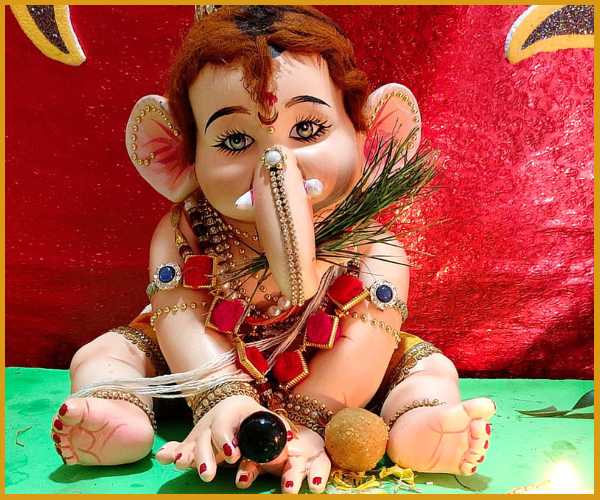- Ganesh Chaturthi is the Hindu festival of worshipping the Lord of Ganas, Vinayak, Musakdhari Lord Ganesha.
- The ritual to worship the beloved son of Lord Shivaji and his wife Parvati had several mythological stories attached to it.
- The elephant-headed lord of beginnings is often worshipped the first as a symbol of peace to make one’s puja complete.
- Also, learn about the various pujas conducted by Hindu Vaktajans and the Ganesh Chaturthi wishes all over the world.
When is Ganesh Chaturthi celebrated?
Ganesh Chaturthi is the auspicious day that falls on Shukla Chaturthitithi in Bhadra month (waxing period of the moon). It falls between August and September depending on the Hindu annual calendar of the year.
Lord Ganesha is worshipped as OM. Om symbolizes the elephant-headed Lord who has one tusk and a curved trunk. Devotees and believers often bow down to Ganesha for an illuminated life.
How does Vaktajans celebrate Ganesh Chaturthi in India?
Ganesh Chaturthi pooja is a beautiful 10 days feast for Indian people, particularly this Ganesh puja is performed by installing Ganesha murtis made up of clays inside the home.
For 10 days people worship Ganesha each day while they also make his favorite sweets like modak and laddus. Offering them in front of him they also feed the little kids with other sweets too.

After the 10 days of Ganesh esthapana at the home, they take Ganesh Bidai with a grand celebration. The clay murti is bidden a goodbye at the Holy Ganga or any river nearby. In between, they perform aartis and pujas and many pandals, sing songs, and many prayers chant Ganesh mantras. Some Ganesh mantras for you!
Om gan ganapathaye namo namaha
Shri sidhivinayaka namo namaha
Ashta vinayaka namo namaha
Ganapathi bappa moraya
How do people fast in Ganesh Choturthi?
Vaktajans abstain from food, from sunrise to sunset, chant these mantras, and burn incense and candles in front of a statuette or image of Ganapati on this Holy occasion.
When is Ganesh Chaturthi marked in 2023?
Ganesh Chaturthi is celebrated on Monday, September 18, by all the Hindu people. People share Ganesh Chothurthi wishes with their friends, and participate in pandals, chant bhajans, and mantras to offer the best regard to Ganesha.
So how do people mark Ganesh Chaturthi in Nepal?
Like other Hindu rituals and festivities, Ganesh Chaturthi has embarked on a meaningful puja and worship in the country of Nepal. Unlike India, the Vaktajans only have a one-day celebration between the Haritalika Teej and Rishi Panchami.
Ganesh Puja is performed in many temples in Nepal, including Suryavinayak, Astavinayak, Chandrabinayak, Muse Ganesh Temple, and many others. Especially, the ladies who have fasted for Hari Talika Teej break their fasting by praying Vinayak with sweets while regular devotees of Ganesh continue their fasting to Rishi Panchami.
Why do we celebrate Ganesh Chaturthi?
The day is also considered a day for some sort of mischievous activities as a tribute to the playful nature of Ganesha. Many old ladies who passed this tradition to youngsters had shared how they used to pick cucumber from someone else’s farm without the owner knowing about it at all.
Also, Read A look back at the Horoscope of Queen Elizabeth II!
The Myth Behind the Origin of Lord Ganesha
Ganesha, the Lord of arts and sciences and the deva of wisdom is the God of beginnings. Before performing any rituals and ceremonies, Ganapati is the one who is persuaded first.
There are two versions of stories about Ganesha Chaturthi actually originated. A story of the birth of Ganapati is to be told. Some say he was born via the dirt of Parvati while she was bathing and some say it’s the result of her fasting.

A version of Ganesha origin from Matsya Purana
In the first case obtained from Matsya Purana, Ganesha rises from the dirt of Parvati but got his head chopped by Shiva as he stopped him at the gate. Without knowing he was the son, the furious Shiva who returned from a long meditation period in the jungle unwittingly harmed his own son. After Mata Parvati threatened to destroy the world, Shiva brought an elephant head and attached it to Ganesha’s body. hence, Ganesha originated.
From then on, the big elephant head symbolized wisdom while the big ears, like a sieve, guided the untouched God to separate the truth from and false.
A version of Brahma Vaivarta Purana for the Ganesh Chaturthi festival
According to Brahma Vaivarta Purana, Lord Ganesh’s birth was confirmed when Parvati was fasting in honor of Lord Vishnu. After fasting for several days, Goddess found a child in her room which is Ganesha. The news about the baby’s birth made everyone surprised and happy.
Eventually, Gods from all lokas come to meet but Shani hesitated to do so because of the curse he had received. When Parvati insisted continuously, Shani despite his wife’s curse look Ganesha. But eying Drishti upon Ganesha turned out to separate Ganesha’s head and body.
The happiness turned into tragedy but Lord Vishnu amidst these brought an elephant head from the Pushpabhadra river. Vishnu has a hand in the revival and creation of Ganesha as per this version.
Happy about the birth, the other gods went to meet the child thinking his eyes will destroy Ganesha. Shani (planet Saturn) did not wish to look at him because his wife cursed him for the same.
Ganesha, one with a large belly became the lord of natural abundance and he was Lord of all the Ganas. He is the power of both knowledge and action. Also, if he walks into one’s life every sorrow and misery will be gone. Musak dhari Ganesh is the protector and healer of all.
Also, Read The Untold Facts about Shravana Nakshatra! Story to Hear






















[…] Also, Read The Significance of Ganesh Chaturthi! A new beginning […]
[…] Also, Read The Significance of Ganesh Chaturthi! A new beginning […]
[…] Also, Read The Significance of Ganesh Chaturthi! A new beginning […]
[…] Also, Read The Significance of Ganesh Chaturthi! A new beginning […]
[…] Also, Read The Significance of Ganesh Chaturthi! A new beginning […]
[…] The Significance of Ganesh Chaturthi! A new beginning […]